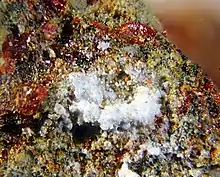Haidingerite
Haidingerite is a calcium arsenate mineral with formula Ca(AsO3OH)·H2O. It crystallizes in the orthorhombic crystal system as short prismatic to equant crystals. It typically occurs as scaly, botryoidal or fibrous coatings.[1] It is soft, Mohs hardness of 2 to 2.5, and has a specific gravity of 2.95. It has refractive indices of nα = 1.590, nβ = 1.602 and nγ = 1.638.[2]
| Haidingerite | |
|---|---|
 White crystals of haidingerite associated with yellow orpiment and red realgar from the White Caps Mine, Manhattan District, Nevada, United States. | |
| General | |
| Category | Mineral |
| Formula (repeating unit) | Ca(AsO3OH)·H2O |
| Identification | |
| Mohs scale hardness | 2 - 2.5 |
| Specific gravity | 2.95 |
It was originally discovered in 1827 in Jáchymov, Czech Republic. It was named to honor Austrian mineralogist Wilhelm Karl Ritter von Haidinger (1795–1871).[3] It occurs as a dehydration product of pharmacolite in the Getchell Mine, Nevada.[1]
See also
References
- http://rruff.geo.arizona.edu/doclib/hom/haidingerite.pdf Mineral Data Publishing, Handbook of Mineralogy
- http://www.mindat.org/min-1797.html Mindat with location data
- http://www.webmineral.com/data/Haidingerite.shtml Webmineral data
- Palache, C., H. Berman, and C. Frondel (1951) Dana’s system of mineralogy, (7th edition), v. II, pp.708–709.
This article is issued from Wikipedia. The text is licensed under Creative Commons - Attribution - Sharealike. Additional terms may apply for the media files.